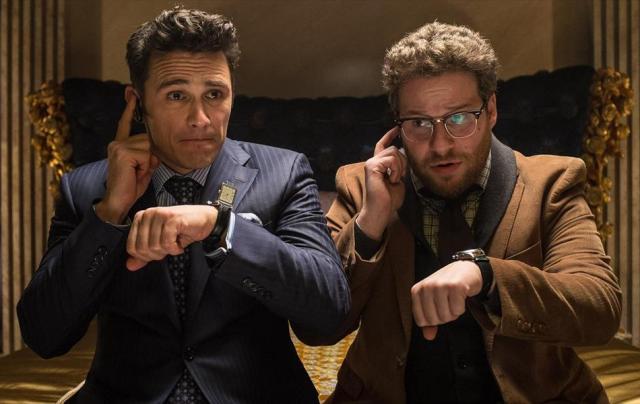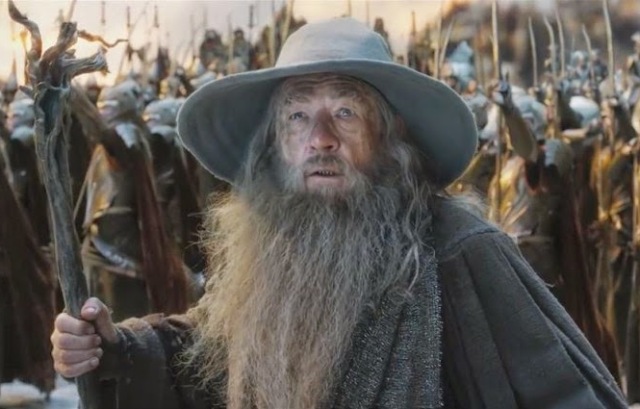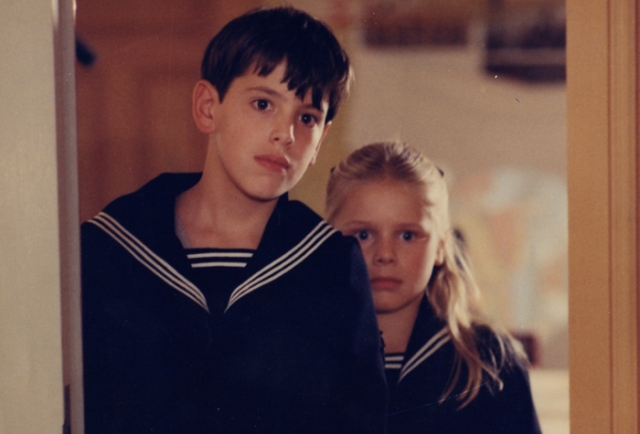Oh what turbulent December it has been for this movie. It’s almost beyond belief that a movie like this could have caused this much trouble, both culturally and politically. And yet, in the last few weeks we’ve seen a major studio brought to it’s knees by anonymous online hackers acting on the behalf of a despotic rogue nation, all with the purpose of removing this movie from public view. The totality of all this actually sounds even more far-fetched than the premise of this purposefully over-the-top movie, and yet this is what happened. Whether writer and star Seth Rogen and his directing partner Evan Goldberg saw this coming or not, their movie now stands as one of the most controversial films of all time, taking a place alongside strange company like Mel Gibson’s The Passion of the Christ (2004), Scorsese’s The Last Temptation of Christ (1988), Monty Python’s Life of Brian (1979), Kubrick’s A Clockwork Orange (1971), and even D.W. Griffith’s The Birth of a Nation (1915). Now, on the surface, The Interview probably shouldn’t be mentioned in the same breath as these movies, and yet it has followed in their footsteps by having been censored because of the objections of powerful influences. In this case, it was the government of North Korea, who objected to the portrayal of their leader Kim Jong-un in the movie, believing that the whole film was making a mockery of him, which is technically true. Not to mention that the whole plot centers around his attempted assassination. But, even though a movie causes a stir elsewhere doesn’t mean it’s deserving of censorship here. Thankfully American cinema is welcoming to most button pushing movies, and any inflammatory film can still find an audience beyond the pressure of outsiders. This one however seems to have been pushed to the brink.
Unfortunately for The Interview, their target in question is as humorless and unpredictable as you can get in this world. Sony Entertainment, which is the parent company of Columbia Pictures, went forward with this movie despite the objections of North Korea. In their eyes, they saw no problem, given that the film-making duo delivered very well on their last project, 2013’s This is the End. Unfortunately for the studio, North Korea was not bluffing about their threats towards Sony and the United States. In the last couple months, a deluge of leaked emails and confidential documents from Sony Entertainment have been made public, putting the company into a maelstrom of controversy. Many of the leaked material purposely puts Sony in an unflattering light, which the news media jumped upon quickly and fanned the flames even further. Now, previously respected industry insiders like studio head Amy Pascal and uber-producer Scott Rudin are struggling to clear up their public images, and in Pascal’s case fighting to keep her job, after off-color remarks have surfaced in their private exchanges. Sony’s private payroll breakdowns have also created a PR nightmare for the company, which has left them crippled in the industry due to their loss of trust and credibility. And then came the threats of public attacks on movie theaters if they were to show The Interview on it’s Christmas release date, which soon led to the choice by many large theater chains to not show the movie as planned. For a brief window of time, The Interview fell into a movie limbo, with no future plans for release, thereby giving a victory to the hackers working on behalf of the North Koreans.
Thankfully, independent movie theaters across the country stepped in and offered to screen the film as planned, ignoring further threats made by anonymous online terrorists and displaying a strong commitment to freedom of speech in this country. I for one don’t blame the big chains for pulling out though. After the massacre in Aurora, Colorado during the midnight screenings of The Dark Knight Rises back in 2012, movie theaters can no longer ignore threats like this anymore, especially when it comes from people who have already caused so much trouble to a major studio. In this case, the movie theaters did the right thing and put safety over profits. Sony Pictures, likewise, may have a whole lot of internal issues right now, but I think they deserve credit for sticking by this project for as long as they have, and by allowing a limited showing in select theaters on the planned release date, they are showing a surprising amount courage as well. If there are any people that have done a disservice to our culture over this whole fiasco, it would be the tabloid news media, who basically gave the cyber-terrorists a power base by regurgitating the leaked material and driving the controversy further with their buzzy headlines. Seth Rogen himself took the media to task over this in an interview he conducted on Sirius XM’s Opie and Jim Norton Show before the movie’s release, saying that people in the news media effectively did exactly what the criminals wanted them to do and that the news essentially became a “pawn shop selling the public stolen goods.” Seth pretty much nailed it right there. The first step the media should have taken was to inform the public about what had been stolen from Sony, and how that could affect our own internet security, but instead they focused only on the scandalous material found in the leaks, thereby emboldening the effectiveness of the cyber-attack. It’s another sad reality of our media driven culture that the outrage became misplaced and that cyber-terrorism won because our news media didn’t do it’s job. And yet, with all this controversy surrounding it, and perhaps even enhanced by it, The Interview went from just another movie into becoming a cultural event that could not be ignored.
So, for now I’m going to stop talking about what I thought about the controversy surrounding the picture and actually get down to how the movie stands on it’s own. Is it really as dangerous as you would be led to believe given all the controversy? For the most part, not really. If you have seen any of Seth Rogen’s other films in the past few years, you pretty much know what to expect from this movie. And in that respect, it actually works quite well. Though the movie was also made available online the same day that it was released quietly into theaters, I still chose to see it on the big screen, which was thankfully available not too far from where I live. The audience experience may have helped to enhance my reaction a bit, but even still, I found myself laughing quite frequently. At the same time, I also recognized that it wasn’t really that scandalous a movie. For the most part, the film actually plays it safe with their concept, never quite making any inflammatory statements about world politics or saying things about North Korea that we didn’t already know. It pretty much is just another showcase for Seth Rogen’s sophomoric style of humor, which admittedly he uses well here. Overall, I’m more shocked than anything that this was the movie that nearly brought down a major studio and made international relations between the US and North Korea further strained. This. A movie where one comedy bit involves a character (played by Seth Rogen himself) inserting a metal capsule into his rectum to hide it. This was considered dangerous. The movie is absurd by design, but the controversy now, in retrospect, seems even more absurd. President Obama even had to make a statement regarding the status of this film, which just shows you the full breadth of how far all this went. It remains to be seen how long lasting the ramifications of all this will be, but from what I saw, it ended up offering a funny diversion on a cold Christmas morning.
The plot, in case you were wondering, involves a successful talk show host named Dave Skylark (a hilarious James Franco), who has become noteworthy for getting his A-list guest stars to spill revealing hidden secrets about their lives on his live air show. Dave’s trusted friend and show producer Aaron Rapaport (Rogen) unexpectedly gets a call one night from a representative of the North Korean government, asking for Skylark to come to the hermit nation and sit down for a one-on-one interview with their reclusive President Kim Jong-un (Randall Park). The two colleagues see this as a big opportunity and quickly make plans for their trip. Before they leave, however, they are visited by CIA Agent Lacey (Lizzy Caplan), who enlists the two men into a secret plan to take assassinate the dictator covertly on their trip. The two agree to go along with the agency’s plans, but once in North Korea, ego and incompetence start to get in the way. All the while, Kim Jong-un proves to be a more cunning diplomat than the two men thought, quickly winning over the dim-witted Skylark with his charm and very big and dangerous toys. Rapaport on the other hand tries to keep the watchful eyes of North Korean propaganda minister Sook (Diana Bang) and Kim Jong-un’s security team from discovering their secret plan while at the same time trying to talk some sense into Skylark before his friend loses himself completely. As you can see, the movie is less of an examination of US and North Korean relations than just a high concept setting for some ridiculous comedy bits.
Setting an absurdist comedy around such a volatile political situation may seem like a case of welcoming the fox into the hen house, but Seth Rogen and Evan Goldberg are not without company. Indeed, Hollywood has been poking fun at dictatorships abroad for many years, no matter how intimidating or dangerous or genocidal they may be. Look at all the propaganda films made around WWII for example. The image of Adolph Hitler in many of our wartime movies contrasts sharply with those in the post war years. During wartime, Hitler was mocked relentlessly as a mad buffoon who incited nothing more than our ridicule at his pathetic attempts at world domination. Charlie Chaplin’s classic comedy The Great Dictator (1940) perfectly lampoons the image of Hitler in these early years, showing the absurdity of Hitler’s grandiose ambitions in a sharp satirical way. However, this kind of practice became less popular once knowledge of Hitler’s true atrocities in the Holocaust came to light. In the years since, it was seen as a dangerous practice to openly mock sitting foreign governments in movies, because some feared that it might spark international incidents in that volatile peacetime period. Of course, once counter-cultural New Hollywood started, those old-fashioned notions started to go away as new satirists like Mel Brooks showed that you can make fun of dictators again and more importantly, make it acceptable. Mel Brooks’ The Producers (1967) not only showed that satire about world politics was necessary, but also that the notion of ignoring it was also absurd. Since then, mocking dictators has become largely commonplace, from Saddam Hussein in Hot Shots Part Deux (1993) to Kim Jong-il in Team America: World Police (2004). And it’s mostly become helpful that until now, Hollywood has never received backlash for mocking world leaders. I guess it only took that one person who didn’t get the joke.
And it’s a shame that politics ended up trumping artistic expression in this case; although I wouldn’t classify this movie as high art. The movie is mostly geared towards making you laugh at it’s main characters self-absorbed antics rather than the political implications of their situation. But, even still, it did make me laugh consistently throughout. The only times when I thought that the movie hit a very introspective point was actually when they made statements about the role of media and public image, which is ironic given what’s happened because of this movie. I believe there was an intentional connection made in the film’s plot where the attempted shutting down of the titular interview by Kim-Jong-un’s government officials is not all that different from a run-in with a celebrity publicist early on in the movie, making it one of the movie’s sharper observations. The rest of the enjoyment in the movie more or less hinges on the absurd antics of the main characters, who most certainly do a great job here. James Franco in particular steals this movie, playing one of the most entertainingly confident idiots I’ve seen in a movie in a long time. Seth Rogen also gets a few good laughs throughout, even while acting as the straight man to Franco’s zanier performance. However, special recognition should go to Korean-American actor Randall Park for his surprisingly nuanced performance as Kim Jong-un. He helps add surprising layers to this real life dictator and actually makes him more than just a generic villain. His scenes with Franco’s Skylark are definitely the film’s highlights and overall help to make this movie resonate more than it normally would have.
So, in the end, is The Interview this groundshaking-ly dangerous movie that we’ve all been led to believe it is? No, it’s just a harmless, goofy comedy; but, still one that took some guts on the filmmakers’ part to pull off. Overall, I’m glad that I took the opportunity I had to go see this. Is it something must be seen now, given all the controversy? Well, if you feel like you want to make a statement about free speech and show that you will not be bullied by cyber-terrorists, than you should put your support behind this movie. But, at the same time, it’s not really a patriotic duty to go see it either. In the end, I’d say that it’s worth watching just for a good laugh. Yes there are some moments that make you see why it would draw the ire of international parties (particularly with the ending), but it’s also nothing really worse than most other political satires that we’ve seen over the years. I think that more focus should be put on how we present ourselves as a culture, and that we shouldn’t let outside forces dictate what we can and cannot watch. Cyber-terrorism is unfortunately a reality of today’s world and one that we’re still trying to understand. But, the last thing we need to do is to embolden these attackers by doing exactly what they want us to do and abandoning our freedoms. In the years form now, the movie may be overshadowed by the controversy that surrounded it, and oddly enough we may even see a movie made based on this whole event itself. But, until we retrospectively examine this in the future, let me just end by saying that The Interview is still an enjoyable film to watch and worth seeking out if it’s playing at a theater near you. It’s a well executed and funny presentation of a hilarious “what if” premise, and I’m sure most of you will get a laugh or more out of it too. You’ll certainly never listen to Katy Perry’s “Fireworks” the same way again after watching it. It may not be the funniest movie ever made, but it certainly has already left it’s mark as one of the most important, which in of itself is hilarious to think about.
Rating: 8/10




